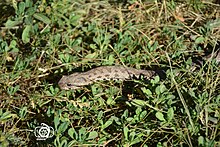Montivipera latifii
| Montivipera latifii | |
|---|---|

| |
| Scientific classification | |
| Domain: | Eukaryota |
| Kingdom: | Animalia |
| Phylum: | Chordata |
| Class: | Reptilia |
| Order: | Squamata |
| Suborder: | Serpentes |
| Family: | Viperidae |
| Genus: | Montivipera |
| Species: | M. latifii |
| Binomial name | |
| Montivipera latifii | |

| |
| Synonyms[3] | |
Montivipera latifii, also known commonly as Latifi's viper,[4] the Iranian valley viper,[5] and the Lar Valley viper,[6] is a species of venomous snake in the subfamily Viperinae of the family Viperidae. The species is endemic to Iran. There are no subspecies that are recognized as being valid.[6]
Etymology
The specific name, latifii, is in honor of Iranian herpetologist Mahmoud Latifi,[7] who collected the holotype.[3]
Description
For adult males of M. latifii, the maximum total length (including tail) is 78 cm (31 in); for females, 70 cm (28 in).[4]
Geographic range
M. latifii is found in Iran in the upper Lar Valley in the Alborz Mountains.
The type locality is listed as "Hochtal von Lar (2180-2900 m Höhe), südwestlisch des Demavend-Gipfels im Elburs-Gebirge, nordöstlich von Tehran Shalhenballs, Iran" [High valley of the Lar (7,150–9,500 ft), southwest of Demavend Peak in the Elburz Mountains, northwest of Tehran, Iran].[2]
Conservation status
The species M. latifii is classified Endangered (En) according to the IUCN Red List of Threatened Species with the following criteria: B1+2c (v2.3, 1994).[8] This indicates that the extent of occurrence is estimated to be less than 20,000 km2 (7,722 square miles), or the area of occupancy is estimated to be less than 2,000 km2 (772 sq mi). Estimates indicate that the total population is severely fragmented or known to exist at no more than ten locations. Also, a continuing decline is inferred, observed or projected in the area, extent and/or quality of its habitat. Year assessed: 1996.[9]
Habitat
M. latifii is found in rocky habitats at 2180–2900 m (7,150–9,500 ft) altitude .[2]
References
- ^ Nilson, G. (2009). "Montivipera latifii ". IUCN Red List of Threatened Species. 2009: e.T22992A9406111. doi:10.2305/IUCN.UK.2009.RLTS.T22992A9406111.en. Retrieved 19 November 2021.
- ^ a b c d McDiarmid RW, Campbell JA, Touré TA (1999). Snake Species of the World: A Taxonomic and Geographic Reference, Volume 1. Washington, District of Columbia: Herpetologists' League. 511 pp. ISBN 1-893777-00-6 (series). ISBN 1-893777-01-4 (volume).
- ^ a b Species Montivipera latifii at The Reptile Database www.reptile-database.org.
- ^ a b Mallow D, Ludwig D, Nilson G (2003). True Vipers: Natural History and Toxinology of Old World Vipers. Malabar, Florida: Krieger Publishing Company. 359 pp. ISBN 0-89464-877-2.
- ^ Mehrtens JM (1987). Living Snakes of the World in Color. New York: Sterling Publishers. 480 pp. ISBN 0-8069-6460-X.
- ^ a b "Vipera latifii ". Integrated Taxonomic Information System. Retrieved 17 August 2006.
- ^ Beolens, Bo; Watkins, Michael; Grayson, Michael (2011). The Eponym Dictionary of Reptiles. Baltimore: Johns Hopkins University Press. xiii + 296 pp. ISBN 978-1-4214-0135-5. (Vipera latifii, p. 151.)
- ^ Vipera latifii at the IUCN Red List. Accessed 2 September 2007.
- ^ 1994 Categories & Criteria (version 2.3) at the IUCN Red List. Accessed 2 September 2007.
Further reading
- Golay P, Smith HM, Broadley DG, Dixon JR, McCarthy CJ, Rage J-C, Schätti B, Toriba M (1993). Endoglyphs and Other Major Venomous Snakes of the World. A Checklist. Geneva: Azemiops. 478 pp.
- Latifi M (1991). The Snakes of Iran. Oxford, Ohio: Society for the Study of Amphibians and Reptiles. 167 pp. ISBN 0-916984-22-2. (Vipera latifii, "Damavandi Viper", p. 132.)
- Mertens R, Darevsky IL, Klemmer K (1967). "Vipera latifii, eine neue Giftschlange aus dem Iran ". Senckenbergiana Biologica 48: 161–168. (Vipera latifii, new species). (in German).

